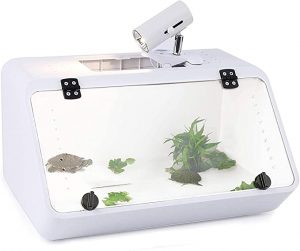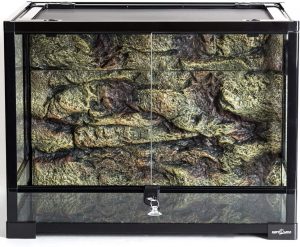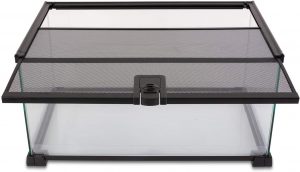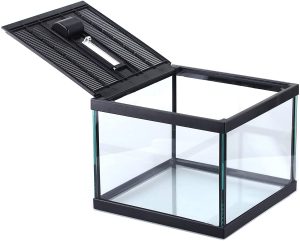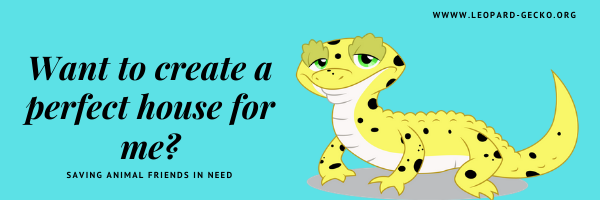Coming from the austere regions of Southeastern Afghanistan, Western India, Pakistan, Iraq, and Iran, Leopard geckos have become one of the most cherished domesticated reptiles in the pet industry today. They are easy to look after and require minimum care. One can easily create a suitable leopard gecko habitat.
But the question arises at how do you keep them and provide a space for them to live in? So, the answer is, you mimic the same environment of a leopard gecko’s habitat from the wild.
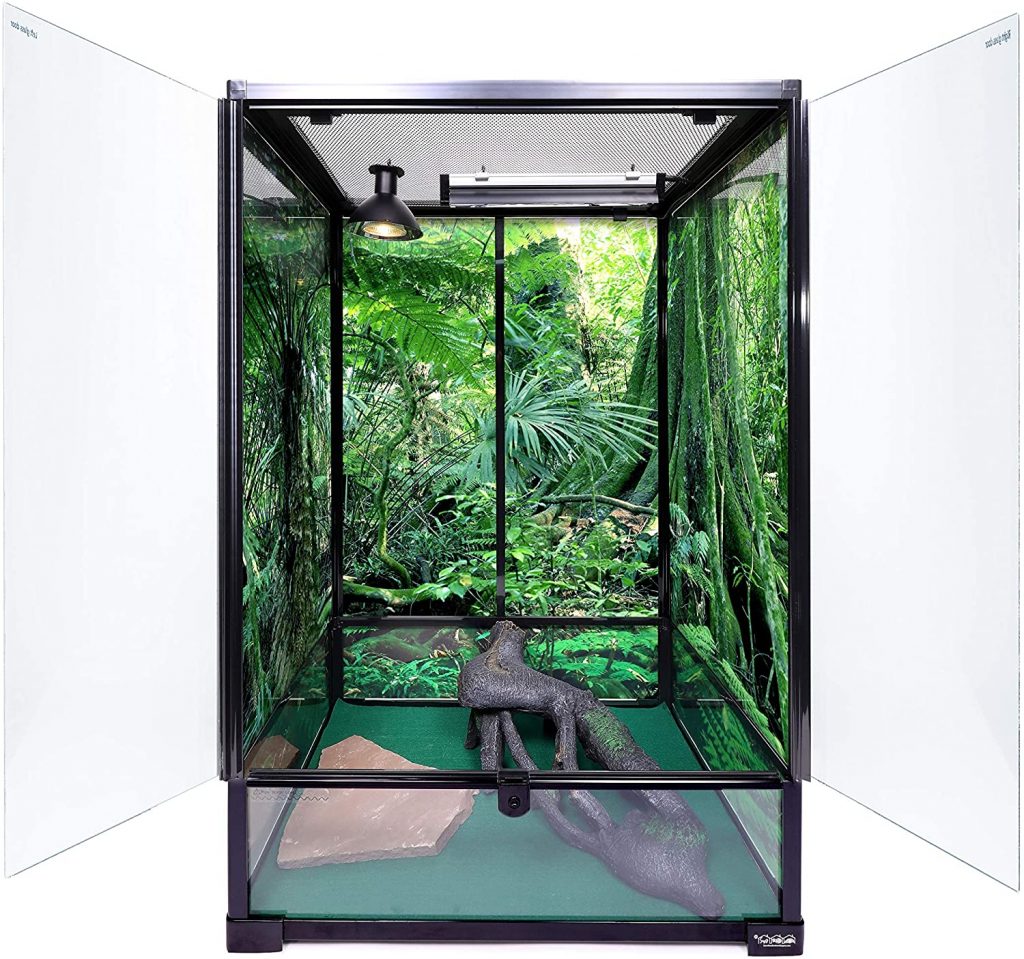
The Best Leopard Gecko Habitat Tanks
Leopard geckos are small lizards which are easy to handle and can be petted at homes. This reptile is available in a variety of colours. The Leopard Gecko has the tendency to understand the command with ease and can be tamed without much hassle.
Unlike the other geckos, they do not have the sticky pads under their feet to climb up the walls but, they have eyelids. This reptile is slow-moving and does not get violent at all.
Pet a Leopard Gecko in your Home
If you wish to pet more than one gecko at your place, then prefer to get a 15-20-gallon tank where you put 2-3 geckos but, only one male per tank is a must. If you are ready for the geckos to produce an offspring, you can put a male and a female together.
If you have an old fish tank which does not hold water anymore, you can easily convert it into one of the best leopard gecko habitats. If you are looking for leopard gecko habitats online then, the following information will help you decide the right one for your pet.
In a Hurry? Here’s Our Top Picks…
Product information correct as of December 31, 2022.
Top Gecko Leopard Habitats
Large See-Through Gecko Tank
This brand is one of the best brands to deal with if looking for the best leopard gecko habitats.
- Dimensions: 19” x 10” x 10”
- If you are looking up for terrariums for young geckos then, this is the one for sure!
- This product is specially made keeping geckos in mind and hence provide your pet with ultimate comfort.
- Temperature and humidity are very important for a gecko’s healthy growth and development and this brand sells the terrarium with a mesh on top for your heat lamps to shine through.
- This tank is very easy to clean and comes with a water-resistant bottom and a rubber plug you can remove.
- If you are on a low budget then this tank is the most amazing thing you can get for your pet.
- The only drawback of this terrarium by CalPalmy is that the tank is made of acrylic so, is light in weight but may break.
REPTI ZOO 34 Gallon Glass Terrarium with Foam
Background
If you are looking for something stylish, which makes your living room look even better, then this is one of the best leopard gecko habitats you can find for your pet.
- Dimensions: 24″ x 18″ x 18″
- The tank has a capacity of about 34 gallons and has a sturdy screen top, making sure that your pet gets an appropriate amount of air and doesn’t even sneak out!
- You can decorate the tank with a lot of plants and other creatures as it has a lot of space to fit in a gecko and some elegant decorations altogether.
- The tank also has a raised bottom frame which makes heating easier as you fit an under-tank heater.
- The only problem with the tank is that it is heavy and a little expensive.
REPTI ZOO 10 Gallon Terrarium with a sliding top
If you are in search of a tank which is neither too big nor too small, then this is just one of the best leopard gecko habitats available in the market.
- The tank measures 20″ x 12″ x 10″ inches which provide your pet to live a spacious life.
- The tank contains a sliding top to access the inside of the habitat without giving a chance to your pet to escape.
- The tank has top ventilation and also consists of a stainless-steel mesh so that the pet does not have room to escape from the habitat easily.
- You can stack these terrariums if you want to keep more than one Leopard Gecko!
- There have been a few reports of damaged deliveries so be sure to check the glass and the corners to make sure nothing has been damaged during delivery.
Crapelles Small Reptile Glass Box Terrarium
- This terrarium from Crapelles provides your home with an elegant yet inexpensive tank for your pet, but only while they’re really small – you’ll soon need to update.
- It is small and can be decorated with plants and accessories for your reptile friend to feel like it’s his own home.
- This terrarium measures only 7.8″ x 7.8″ x 5.9″ is highly durable and sturdy.
- The only thing which can be a problem is that you’ll need to upgrade your terrarium quickly as your Leopard Gecko grows into adulthood.
Crapelles Terrarium Easy Assembly
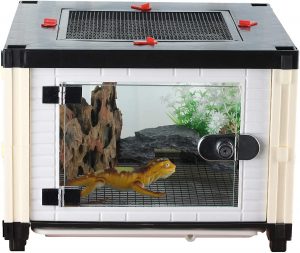
If you are searching around for an amazingly comfortable
habitat for your gecko, then you can
choose this
starter kit for sure!
- This is one of the best leopard gecko habitats available for your home with an amazing price range and comfort all in one.
- This company makes sure that you get the cosiest home for your pet and hence make sure everything is made up of good quality material is sturdy and durable in nature.
- Lots of air circulation to keep your Leopard Gecko healthy.
- Slideable base plate to catch anything that falls through the mesh.
- A drawback is that your Gecko may get their feed stuck in the lower mesh.
Leopard Gecko Habitat – The Gecko Home
So, how should you set up the perfect leopard gecko habitat? How can you incorporate all the elements from the native leopard gecko habitat inside a tank?
What are these elements, and how will you find the right ones in the market?
If you too are wondering and confused while trying to figure out these questions, then we have it all sorted for you.
Consider the following steps to build the perfect leopard gecko habitat before bringing it into captivity.
- 15-gallon reptile tank is a must for the leopard gecko habitat
- UV/U VB light kit – or- vitamin D3 supplements
- Reptile heating pad
- humidity gauge
- reptile foggier, or sphagnum peat moss is necessary for maintaining humidity in the leopard gecko’s habitat
- furniture for the leopard gecko’s habitat
- water dish
- Substrate required for the leopard gecko’s habitat
- Once you have this checklist, you’re all ready to head to the nearest pet store.
Types of Leopard Gecko Habitat
The Exo Terra Glass Terrarium
The Exo Terra Glass Terrarium is the number one terrarium in our list. It is ideal for a reptile or amphibian housing. Designed by European herpetologists it is an ideal tank for a large leopard gecko habitat.
| Product Name | Product Preview | Check Price |
|---|---|---|
| EXO Terra Glass Terrarium |
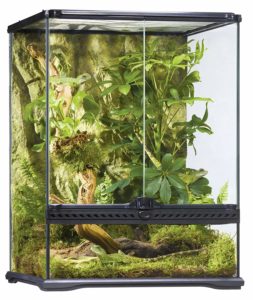
|
Check Price |
Product Dimensions: 18 x 24 x 18 inches ; 33.5 pounds
Shipping Weight: 36 pounds
- The front opening doors allow easy access for maintenance and feeding. A specially designed lock will prevent escape, and the doors can be opened separately.
- The full-screen top ventilation allows U VB and infrared penetration and is completely removable for easy access while decorating or cleaning. At the back of the screen cover, are five closable wire or tube inlets on both sides to install Heat Wave Rocks, Waterfalls, sensors, etc. inside the terrarium.
- The bottom plate of the terrarium is raised to mount a heating pad to heat a part of the extended ground surface.
- The extra high fixed front window is ideal for thick layers of substrates (burrowing reptiles), marine parts (paludarium) or to mount an Exo Terra reptile den. The natural background is in the same colour as all other Exo Terra decoration items and provides an extra climbing dimension.
- Heat this terrarium using an EXO Terra LIGHT DOME / ALUMINUM UV REFLECTOR LAMP in conjunction with the EXO Terra LIGHT BRACKET / LIGHT DOME SUPPORT FIXTURE. Other lamps and fixtures are not approved as they may cause product damage and pose a fire hazard.
- The dual front opening doors allow easy access for maintenance, misting and feeding. During terrarium maintenance, one entry can be kept closed at all times; reducing the risk of escape by a flying reptile or feeder insect, and better retains the heat and humidity inside at the same time. Pivoting doors are far superior to sliding doors, as sand and other debris can jam the sliding doors of your leopard gecko’s habitat and guess what, this one has a pivoting door.
We’ve tried and tested this one, and it is perfect for an adult Leopard gecko or a pair of male and female.
EXO Terra Glass Natural Terrarium
EXO Terra Glass Natural Terrarium Nano/Tall – 8 x 8 x 12 Inches Another practical design which is very convenient to create a leopard gecko habitat.
| Product Name | Product Preview | Check Price |
|---|---|---|
| EXO Terra Glass Natural Terrarium |
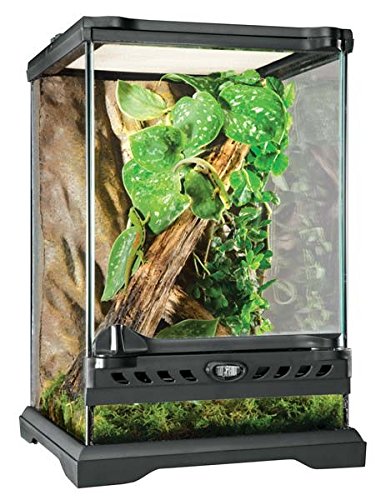
|
Check Price |
- The front opening doors allow easy access for maintenance and feeding. A specially designed lock will prevent escape, and the doors can be opened separately.
- The full-screen top ventilation allows U VB and infrared penetration and is completely removable for easy access while decorating or cleaning
- The bottom plate of the terrarium is raised to mount a substrate heater to heat a part of the extended ground surface.
It has a Waterproof Base
- The extra high fixed front lower panel allows for deep layers of substrate, provides space for glass mounted decor like the EXO Terra Reptile Den or can be used to create a water feature as high as the ventilation strip. Every terrarium is tested for leaks.
It has a Raised Bottom Frame
The bottom glass panel of the terrarium is raised to facilitate the mounting of a substrate heater or heat cable. It prevents heating accessory problems which are typically associated with standard “aquarium style” terrariums.
- It keeps the entire bottom panel well ventilated to ensure optimal hot and cold spots in the leopard gecko’s habitat.
An Enlarged Ground Surface
- The EXO Terra terrarium is more profound than the “Aquarium-type” tank, resulting in an extended ground surface for your leopard gecko’s habitat. This gives the space needed for dessert and ground-dwelling reptiles like the leopard gecko to thrive.
A Natural-Looking Rock Background
- The natural-looking rock background is in the same colour family as other EXO Terra accessories blending nicely for a natural-looking leopard gecko habitat. The environment provides an extra climbing dimension and endless terrarium design opportunities. The background also provides channels for running cords and tubing from the bottom to the top of the terrarium without being seen.
Habitat Kit Rainforest
Habitat Kit Rainforest / Starter Kit This EXO Terra Rainforest Habitat Kit is the ideal set-up for the beginning herpetoculturist who are on a quest to make that perfect leopard gecko habitat!
| Product Name | Product Preview | Check Price |
|---|---|---|
| Rainforest Habitat Kit (includes PT2607) |
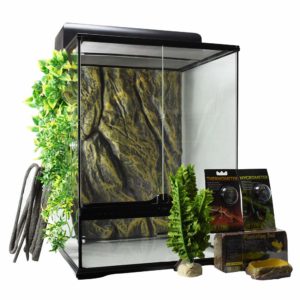
|
Check Price |
Product dimensions: The tank is 18″x 18″ on the bottom and 24″ tall.
It is ideal for two leopard geckos and is the best deal in the market.
- The kit comes with all the components necessary to give your terrarium hobby a successful start – including the EXO Terra Glass Terrarium, designed by European herpetologists.
- The Exo Terra Glass Terrarium features front opening doors, allowing easy access for maintenance and feeding. The full-screen top ventilation permits the U VB rays from the compact fluorescent lighting system to penetrate deep into the terrarium.
- If you’re a beginner, we’d recommend the Habitat rainforest kit. It comes with a block of the substrate for the bottom of the tank, two hanging plants (with suction cups), one ground plant with a substantial base, one bend-a-branch which is about 6 feet long, one small water dish, the light hood – bulbs not included.
EXO Terra Terrarium Reptile Habitat
This tank is for the little ones. For the baby leopard geckos, this Nano terrarium is apt. It is the smaller sized terrarium of the EXO Terra glass terrarium (option 1).
| Product Name | Product Preview | Check Price |
|---|---|---|
| EXO Terra Terrarium 8x8x8 |
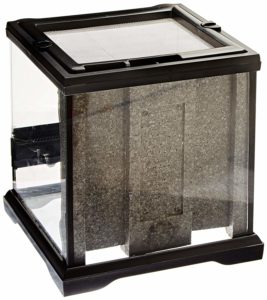
|
Check Price |
Product dimension: 8″x 8″x 8″
- The front opening doors (single door on the Nano terrariums) allow easy access for maintenance and feeding
- A specially designed lock which will prevent escape and can be opened separately.
- It has all the features of the EXO Terra glass terrarium, except for this one is smaller in size and therefore a perfect match for the baby Leopard gecko’s habitat.
Exo Terra All Glass Terrarium
| Product Name | Product Preview | Check Price |
|---|---|---|
| Exo Terra All Glass Terrarium Dual Doors |
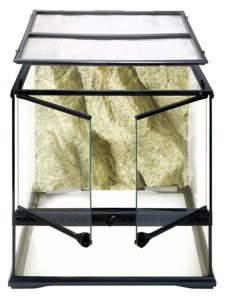
|
Check Price |
Dual Doors:
- The dual front opening doors (single door on Nanos) allow easy access for feeding, maintaining and misting your leopard gecko’s habitat. During terrarium maintenance, one door can be kept closed at all times; reducing the risk of escape by a flying reptile or feeder insect, and better retains the heat and humidity inside at the same time. Pivoting doors are far superior to sliding doors, as sand and other debris can jam the sliding doors.
- A reliable, specially designed lock prevents unwanted opening from children or pets and is an extra security measure to keep the animals in the terrarium.
- The bottom is sealed and rated to hold water. Cheaper terrariums are not and may or may not leak. If you are going to build any vivarium, this is your tank.
- The back wall gives a great look by adding to the aesthetics and function of the tank.
- The build quality is excellent all around. Suitable materials, holes to run cables inside, underneath, anywhere you would need to.
- The most obvious but the best. As well as an opening on top, this product has two front opening glass doors. It makes it easy to set up the tank, but most importantly, you will find yourself interacting so much more with your pet because it’s so easy. You’ll not have to remove lights and heat lamps every time you want to get to them. You can flip a switch open the door, and there they are
- You wouldn’t want to go back to anything else after using this tank.
Exo-Terra-Glass-Terrarium-12-Inch
| Product Name | Product Preview | Check Price |
|---|---|---|
| Exo Terra Allglass Terrarium 18x36x24 |
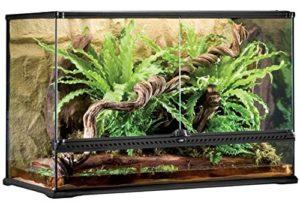
|
Check Price |
The EXO Terra All glass Terrariums yet another amazing terrarium with its patented front window ventilation. It the large-wide version of the EXO Terra glass terrariums. (option 1)
- It has a raised, waterproof bottom frame to fit a substrate heater.
- An extended ground surface that is perfect for ground-dwelling reptiles like the leopard gecko.
- It comes fully assembled out of the box, so you don’t have to worry.
- It is a large-wide terrarium with dimensions of 24 x 36 x 18 inches.
HOW TO CHOOSE THE RIGHT ENCLOSURE/CAGE FOR YOUR LEOPARD GECKO HABITAT?
-
The quest for the best leopard gecko habitat begins with
selecting the best terrariums for it. These terrariums are
those that have more floor space as compared to the height
of the tank. The toes of the leopard Gecko does not have
adhesive lamellae due to which it cannot climb walls or
vertical surface. These creatures are terrestrial animals
and therefore, don’t require
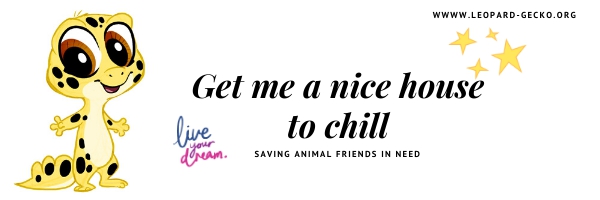 unnecessary height. Floor space is what matters the most
in the case of Leopard Geckos.
unnecessary height. Floor space is what matters the most
in the case of Leopard Geckos.
- Plastic tubs, Fish tanks or specially designed reptile vivariums/terrarium/tanks, work very well for correctly to build leopard gecko habitat and they can be kept in any of these as long as their basic requirements are fulfilled. A standard 10-gallon aquarium (measuring 20 inches in length, 10 inches in breadth, and 12 inches in height) is sufficient for a single baby Leo.
- For adults, a standard 20-gallon tank (measuring 30 inches in length, 12 inches in breadth and 12 inches in height) would be the smallest size recommended. Avoid putting more than two in a 20-gallon tank. Never put two males in one container. They will end up fighting and injuring each other. Increase the tank size if you add females to the tank with the male. Also never house an adult and a baby Gecko together. These points are a must to build a happy leopard gecko habitat.
- Make sure the size of the tank isn’t too big for the size of the Leopard gecko. Large tanks don’t heat properly. As a result, the gecko feels uncomfortable, which causes it stress.
- Wire cages are unacceptable as they will not maintain the required temperature for the lizards. They must always be housed in glass terrariums for safety reasons. Glass tanks are also beneficial in maintaining the temperature needed by preventing the heat from escaping.
HOW TO DECORATE THE LEOPARD GECKO TANK?
The geckos are some of the most common household pets around the world, especially the USA. Therefore, learning how to recreate the authentic leopard gecko habitat as in the wild is a challenge in itself.
You need to find the right side of the cage, the suitable substrate, heating pad, hygrometer, lighting, and other vital instruments to ensure the transition into the domesticated environment is smooth and comfortable for your pets.
TEMPERATURE
- Maintaining the perfect temperature along with the humidity plays a significant role in creating the comfortable leopard gecko habitat.
- First and foremost, you’ll need a heat mat along with a thermostat to maintain the temperature of the heat mat. The heating pad works best when it covers the only 2/3rd of the bottom of the tank. This will create a warm spot and a cool spot creating a temperature gradient which is required for the Leopard gecko. Ceramic lamps and heat bulbs are also options, but they don’t create a temperature gradient. Heat lamps continue to radiate heat in the tank. The constant emission of heat makes the tank too warm, causing an uncomfortable environment for the gecko. This sudden rise in temperature causes your pet to stress. Although, the temperature gradient can be caused by heat lamps and bulbs too but its more comfortable with heating pads.
- Then, you’ll need a digital thermometer and place it near the heat pad so that you can scan the temperature. This will give you the exact temperature instead of the temperature of the walls of the tank. The warm side of the tank where the heat mat is placed should be around 32 to 34 degrees. The midsection is usually 22 to 24 degrees and frozen section, from 18 to 21 degrees.
- These reptiles perform ‘Thermoregulation’, which means that they will move into hotter or colder areas to raise or lower their body temperature as required. Therefore, their tank is set up in such a manner that they get a different pressure gradient throughout the vivarium.
LIGHT
- Lighting is an aesthetic option in making a natural leopard gecko habitat as Leopard Geckos don’t bask in the sunlight. They are thermal creatures with traits of nocturnal animals and therefore don’t require Ultraviolet light-B as much as other species. Although a 2.4% U VB light can be used. Many keepers recommend the Arcadia 8 watt MINI UV light Kit 2.4% U VB. This is an extremely low-level source of U VB and is safe for even very shallow tanks.
- Also, a fluorescent daylight bulb set on a timer can be used to keep the day-night cycle in check. A red light lamp which is designed explicitly for nocturnal reptiles can also be considered. Avoid incandescent or full-spectrum heat lamps, as the geckos aren’t fond of bright light. Some breeders have had better luck with an indoor light source for keeping their herps healthy, while others have noticed no significant difference between the two
SUBSTRATE
- You could use soil mixture, or use sand and soil mixture as a substrate which will give the tank a more natural look like the authentic leopard gecko’s habitat. Although, sand can be accidentally ingested and be risky at times, leading to death. Some, therefore prefer simple substrates like paper towels, newspapers, stone tile or carpeting, which is specially designed for reptiles.
- A reptile carpet would allow the heat to flow more quickly through the heat mat as compared to other substrates that are denser. It’s an only major drawback is that it is challenging to clean, thereby leaving traces and marks of the feces and leftover dead worms.
- Newspapers and towels are easier to clean and replace but are combustible. They may catch fire if they get too hot. Therefore while using newspaper or paper towels as the substrate always make sure that they are not overly heated as by doing so, you’re creating a fire hazard for your pet.
- Slate tiles are easy to clean, but they are not comfortable for your pet. They prevent the transfer of heat from the source and in general, are more expensive.
- These fragile reptiles have sensitive skin, so one should use non – abrasive, non – irritating substrates. It should be something that you can easily clean and replace without creating any dust. Items like cedar, pine, hardwood chips, gravel, cat litter, sawdust, and corncob bedding shouldn’t be used as substrates.
DRY HIDES FOR THE LEOPARD GECKO
- These are conscious animals and can project an enlightened display of emotions to the new objects added the leopard gecko’s habitat. This furniture can encourage exercise, and places to hide. They like to crawl and climb on top of rocks. Therefore, specific pieces can help promote their movement, which creates a stimulating and enjoyable leopard gecko habitat.
- Areas to hide consist of commercial hide boxes, overlapping rocks, inverted clay pots and sections of curved wooden barks. These shelters provide the gecko with a place to conceal himself and sleep.
- Dry hides are necessary to give the Geckos a sense of security and safety. It provides the creature with a safe environment as it would get in its natural leopard gecko habitat. Objects like plastic plant saucers with a hole can be used as a hide as well. Cork bark which is relatively inexpensive and lightweight is also a good option. It also gives the vivarium a naturalistic appearance to your leopard gecko’s habitat. Apart from these practical setups, there are a variety of options available in the market. Place the warm hide on top of the heat mat, and you’re good to go.
- The more natural and elaborate the setup of the vivarium, the better and closer it looks to the leopard gecko’s habitat. Substances like rocks and logs will provide your pet to climb and take shelter. It will also create a natural space for him to live in. You can also use succulent plants for decorating the vivarium. It gives a more naturalistic look to the tank and is easy to maintain, unlike other natural plants.
- While your leopard geckos are little (under 6 inches long), line the floor of their home with reptile carpet. Once they’re bigger, switch to a 2- or 3-inch layer of calcium sand. Remove droppings every week and change out their bedding once a month.
HUMID HIDES AND HUMIDITY REQUIRED FOR THE LEOPARD GECKO
- Leopard Geckos have particular humidity requirements ranging from 40 to 60%. This is to encourage proper shedding cycles and prevent dehydration. A high humidity level can leave your gecko more susceptible to infections.
- The ideal humidity level should be 40% or lower, and you should monitor it using a hygrometer. It can also be maintained using a reptile fogger. Reptile foggers are humidifiers, with a bendable hose. The humidifiers release the humidity through the tube and into the enclosure. The only drawback is that they could create too much humidity. And too much humidity can encourage fungal growth, which leads to respiratory problems. Therefore make sure to find a reptile fogger with control settings.
- Leopard Geckos require “humidified shelters” or a “moist box” to help facilitate shedding. These moist hideaways can be created by lining a shelter or box with wet substrates, such as sphagnum moss, peat moss, damp soil or other products. Add a humidity gauge to monitor the humidity easily without any hassle. A lot of humidity gauges are synchronised with thermometers. So there’s plenty of dual-purpose gadgets available that will help you monitor the proper climate of the leopard gecko’s habitat.
FURNITURE FOR THE LEOPARD GECKO HABITAT
There are a variety of types of furniture available in the market to add to your pets tanks. The furniture adds to the uniqueness of the tank and created hides and places for the gecko to rest. It gives them plenty of options to choose from and encourages them to move, climb and crawl. This keeps them active and prevents them from gaining weight.
- A basking area can be a flat smooth rock or wood under the light. Make sure it’s not high enough for the Gecko to come in close contact with the light source. This can burn the skin and cause damage to it. If you’re planning to keep rocks, avoid using sharp, pointed rocks as they can injure the Gecko during shedding.
- A water container to store water for the pet is a crucial one. Provide water in a flat, shallow bowl, and change it daily. If there is a fecal matter or drowned feeder insects in the water, change it immediately. Avoid using deep bowls, as this will limit your gecko’s access to his water as well as present a drowning hazard to both your gecko and the feeder insects you give him.
- Add plants to give your tank a more naturalistic look to the leopard gecko’s habitat. You could add succulent plants of different types. These plants need low maintenance and look beautiful although make sure to check for any kinds of allergies if your pet has from plants.
BIOACTIVE TANKS TO CREATE THE LEOPARD GECKO HABITAT
Bioactive terrariums for leopard gecko habitat are tanks with an ecosystem incorporating live plants, live insects, soil that live in synergy. A live ecosystem that functions on its own by relying on each other.
These live tanks are currently prevalent than ever to create that perfect leopard gecko habitat. They are fascinating, and the constant change and growth that takes place inside the tank make it a subject of interest for both the keeper and the pet.
This involves keeping your reptiles in a living ecosystem cohabiting with other organisms that form part of a natural environment.
Now as much as it sounds interesting, maintaining a Bioactive tank needs experience and regular monitoring. Here are the following steps required to set up a Bioactive tank for the leopard gecko habitat.
VIVARIUMS FOR THE LEOPARD GECKO’S HABITAT
Like any other kind of leopard gecko habitat, the perfect type of vivarium is essential for the Bioactive leopard gecko habitats as well. Select a good quality vivarium with proper lamination that will protect the boards.
In an arid setup, the substrate should not be too wet, so no extra lining inside is required. The inside joints of the vivarium must be sealed with a silicone sealant to prevent any leakage.
This protects the vivarium from moisture damage.
A NATURAL BACKGROUND FOR THE LEOPARD GECKO’S HABITAT
By fitting a natural background inside the vivarium makes the setup look better, it also adds to the naturalistic look within the vivarium of the leopard gecko’s habitat.
The background may have a 3-dimensional surface which allows certain reptiles and insects to climb.
Backgrounds with real cork will also absorb and release moisture inside the vivarium depending upon the temperature and humidity inside.
Make sure you run any electrical wires over the background before you push it into its final position. Also, make sure that you do not block any ventilation.
INSTALL THE ELECTRICAL’S
The electrical equipment you use inside your vivarium will mostly depend upon the species of reptile you are looking to keep. As for the vivarium for a leopard gecko’s habitat, install a basking lamp and a 6% U VB tube.
No matter which species of reptile you are keeping, you will require a lamp for plant growth, for example, an Arcadia Jungle Dawn LED secured to the vivarium roof with a Jungle Dawn bracket.
SETTING UP HARD LANDSCAPING FOR THE LEOPARD GECKO’S HABITAT
You need to create a solid foundation for your landscape. For keeping leopard geckos, you need to give them hiding places throughout the vivarium.
The hiding spots make the leopard gecko habitat a lot more comfortable for Leo and also adds a sense of safety in their mind.
Using natural wooden log hides you can manage to provide these hides while still maintaining a natural leopard gecko habitat. Although, make sure to check on the wooden coats as they catch fungus quite swiftly due to the moisture present the tank.
Other alternative can be to hides that look like wood but are made of concrete.
The electrical equipment you use inside your vivarium will mostly depend upon the species of reptile you are looking to keep.
As for the vivarium for a leopard gecko’s habitat, install a basking lamp and a 6% UVB tube.
No matter which species of reptile you are keeping, you will require a lamp for plant growth, for example, an Arcadia Jungle Dawn LED secured to the vivarium roof with a Jungle Dawn bracket.
THE RIGHT SUBSTRATE FOR THE LEOPARD GECKO’S HABITAT
The right type of substrate is significant for your Bioactive leopard gecko habitat vivarium. For a relatively dry setup, you do not need to use a drainage layer.
The substrate needs to be a soil/ sand mix which will allow plants to spread its root into it but also provides drainage from the top.
In an arid ecosystem, the substrate will form a crust on the surface as it’ll dry up, which will trap moisture below which is essential for live plants and clean up crew.
Brands like Arcadia Earth Mix Arid, Pro Rep Bio Life Desert can good options, to begin with.
The ideal depth of substrate should be around 5 cm to enable a correct moisture gradient.
ADDING LIFE TO THE LEOPARD GECKO’S HABITAT (PLANTS)
This is the fun part! Plants that grow in arid environments such as cacti, aloes, and other succulents will be perfect for this kind of setup. When choosing your plants, consider their final size and how that will impact the overall effect of your display.
Plants often look more natural when planted in clumps of their kind, and this will become more apparent as they grow and spread.
You can use plants like, ebony wax agave (Echeveria ebony), Harworthia enon, living stones (Lithops sp.), Socotra aloe (Aloe squarrosa), burrito sedum (Sedum burrito), warty bacteria (Gasteria “little warty”), short-leaved aloe (Aloe brevifolia) and snake plant (Sansevieria mikado).
Water them thoroughly during the initial period, so they settle down in the substrate.
INTRODUCING THE CLEAN-UP TO THE LEOPARD GECKO’S HABITAT
The clean-up crews are the animals and worms that will be sharing their home with your reptiles. These small creatures take care of the waste generated by the pet in the vivarium.
This takes your maintenance time down to a minimum and keeps your substrate alive, thereby keeping the leopard gecko’s habitat healthy.
Just like the importance of earthworms to your garden plants, the clean-up crew is essential to the tank and the substrate.
Your clean-up crew works within the substrate, recycling nutrients, preventing it from becoming stagnant and making it an excellent source for your plants to grow in.
Choose your clean-up crew according to the type of ecosystem you’re planning to make in the vivarium. Bugs like Morio worms, woodlice and springtails can tolerate the warmer temperature.
These invertebrates working away can be just as fascinating as the reptiles!
INTRODUCE YOUR LEOPARD GECKO
Bioactive enclosures are currently more popular than ever for leopard gecko habitats. If you’re unfamiliar with the phrase ‘bioactive’ in terms of reptile keeping, it means keeping your reptiles in a living ecosystem cohabiting with other organisms that form part of a natural environment.
This may include live plants, as well as ‘clean-up crew‘ critters that clean up and recycle waste in the enclosure. A balance between display animals, plants and clean-up crew with be achieved, and the enclosure becomes almost self-maintaining.
CLEANLINESS REQUIRED FOR THE LEOPARD GECKO
- A healthy habitat is a must when you domesticate a Leopard gecko. An unhealthy leopard gecko habitat will cause various diseases and litter the substrate which comes in direct contact with your pet.
- Remove the waste, dead insects and shredded skin and change the substrate occasionally. They tend to eat the skin they shed every month. Although some experts believe that the surface is a rich source of vitamins and protein necessary for growth.
- Avoid any chemical disinfectants like phenol, pine scents. These items are toxic for the leopard gecko’s habitat and its health. If you’re unsure of the products to use consult a Vet. Clean and disinfect the habitat at least once a week with a 3% bleach solution. Rinse it thoroughly with water and remove all traces of bleach smell. Dry the tank completely and add clean and fresh substrate.
- Keep a constant check on their water containers for any dead worm or cricket that might be floating on it. Change the water regularly to prevent it from fouling the leopard gecko’s habitat.
- Avoid using deep bowls for serving water as the baby geckos can drown in them.
- Monthly cleanings are essential for the sanitation of the leopard gecko’s habitat. This will need you to remove all the furniture and substrates. To do that you’ll first need a temporary home for your leopard gecko.
- The first tip is to have a sick bay ready. A sickbay is a temporary home that you will need to place your leopard gecko in while you clean its tank. It does not have to be over the top, or exactly like their enclosure. Instead, a simple Tupperware tub with a piece of furniture and an easy to clean substrate is enough to place your gecko in for two hours or whatever time you require. Although, make sure you don’t keep it in the tub for too long.
- If your gecko needs long-term isolation due to illness or injury, you may want your sickbay to be a little more complete, with a water dish included. But for routine maintenance, place your friend carefully in sickbay. Be cautious while picking him up, and only carry him by the mid-section. Picking them up by their tail can harm them, therefore, be very particular while you handle them.
- A moist area is an indispensable part of your leopard gecko’s habitat. This essential little compartment is kept at a higher humidity than the rest of the habitat. And the purpose of this is to aid in proper skin shedding.
- Most keepers like to place damp sphagnum moss inside a ready-made hide (if you make your own from a plastic tub make sure to sand the edges of the entrance hole to prevent cuts in the gecko’s skin.) The higher humidity in this area encourages healthy shedding. If the skin becomes too dry, it could stick to the gecko, causing health problems.
- For example, a widespread problem is when the old skin is left on the feet, this can shrink and restrict the blood flow to the toes, causing the leopard gecko (especially juveniles) to develop shortened or completely missing toes. In the same manner, drying the skin around the eyes that is not adequately shed can result in eye damage.
- In case if a tail drop occurs, place your Leo in sickbay and sterilise everything. Remove the substrate, water dish, climbing rocks, furniture, and even the sphagnum moss. Then either soak in a solution of bleach for 30 minutes or throw it all in a dishwasher. Even the moss can go in if contained in a mesh bag. The National Sanitation Foundation offers a list of dishwashers that they can certify as capable of providing the sterilisation needed.
- While the furniture is washing, do the house itself. Spray the sides and bottom (paying particular attention to corners), with a bleach solution recommended for hospital use. Do not use scented bleach of any kind.
- Let the habitat sit for 30 minutes, wipe it down, and let it dry for another hour. Then put your habitat back together, with your newly sterilised furniture and place your Leo back inside. Leave him or her undisturbed for 48 hours (no handling) because he/she will be feeling a bit low. The tail contains energy reserves needed for fueling a flight response under circumstances where your Leo needs to walk, and the rear has stayed attached. When the back does come off, its as if the booster rockets were jettisoned, so let your little friend rest and recover in their newly sanitised digs.
- The tail comprises nearly 10% of the gecko’s body fat, according to South African gecko researchers Patricia Fleming and others. Dr Fleming and her colleagues stated that tails seem to be packed with fats specifically dedicated as fuel for running. So tail drop will be experienced as a crash diet for a while, and those never make us feel on top of the world.
- While critical to proper shedding, it can also be a little bit of a sanitation problem. The moss should be lightly moistened daily, but should never be soaking wet. Overly wet moss can become a problem in its own right by growing fungi which can affect a gecko’s skin and lungs. Again, removing the hide and its contents and sanitising weekly in the dishwasher or sink will prevent fungal infections, as will managing the water content of the moss itself.
HOW TO HANDLE A LEOPARD GECKO?
- Always have the Gecko examined by a vet before purchasing it. They could have parasites in their intestines that could cause severe disease.
- Gastroenteritis is a condition caused by a bacterial infection due to unsanitary conditions in the leopard gecko’s habitat. This leads to symptoms such as diarrhea. As a result, geckos may excrete watery and bloody stool.
- Never feed your Leopard geckos with insects from the wild or your garden. Only breed them with captive-bred insects.
- Dust the insects with the correct supplements as mentioned above. Feed them with vegetable scrap and hydrate them with water-based foods. If your insects are healthy, your pet will be healthy.
- Leopard Geckos are reasonably friendly and docile creatures. The scoop technique is mostly suggested to pick them up as it helps them tame quickly.
- Rough handling can have opposite effects. The gecko won’t trust you very much. It can even eject its tail, it will eventually come back but won’t be the same. Avoid handling your leopard gecko your friends, especially the ones that don’t have an idea of how to handle one.
- Never handle a Leo by its tail.
- Don’t get them in front of cats or dogs, basically anything that will expose them to too much stress.
COMMON HEALTH ISSUES RELATED TO LEOPARD GECKO
-
Gastrointestinal disease:
If your pet is excreting runny, bloody, caked or smeared stool around the vent region, and there is a loss in its appetite, it could be due to a bacterial or parasitic infection in the intestine. Consult the vet immediately.
-
Metabolic bone/vitamin deficiency:
Inability to absorb calcium due to insufficient U VB light in the leopard gecko’s habitat or due to lack of Vitamin D/calcium supplements. If untreated, it can lead to deformities and softened bones, lethargy, and swollen limbs. Provide ample U VB lighting in the leopard gecko’s habitat and proper calcium and vitamin D supplements.
-
Respiratory disease:
Laboured breathing and mucus in the mouth or nose. It is caused due to an unstable habitat which is too cold or damp. Ensure that the habitat is of proper temperature with separate dry and humid hides in the leopard gecko’s habitat.






